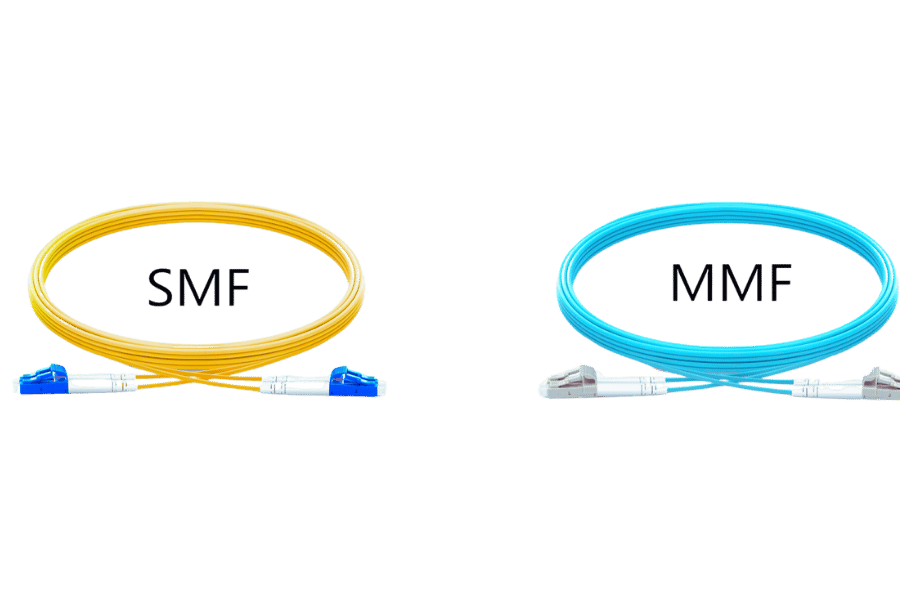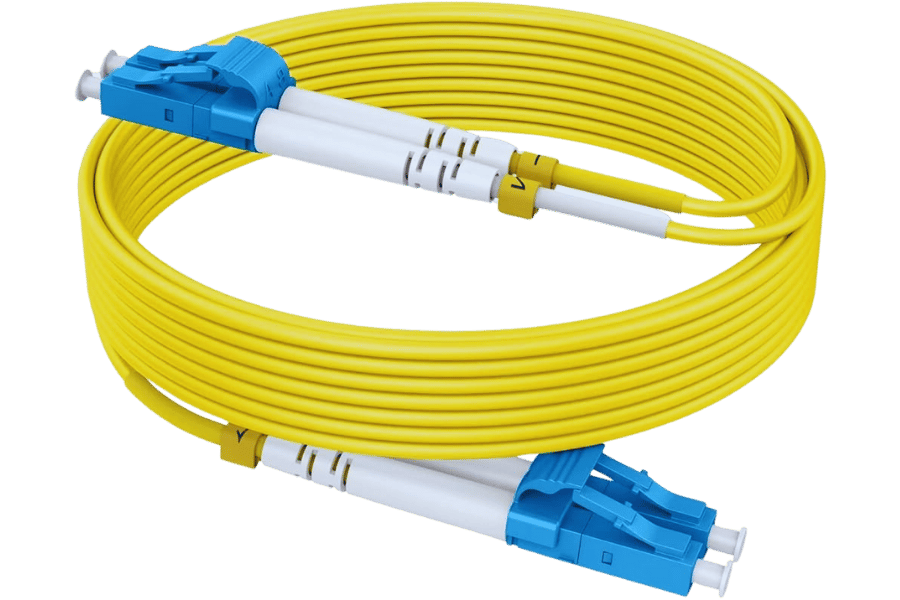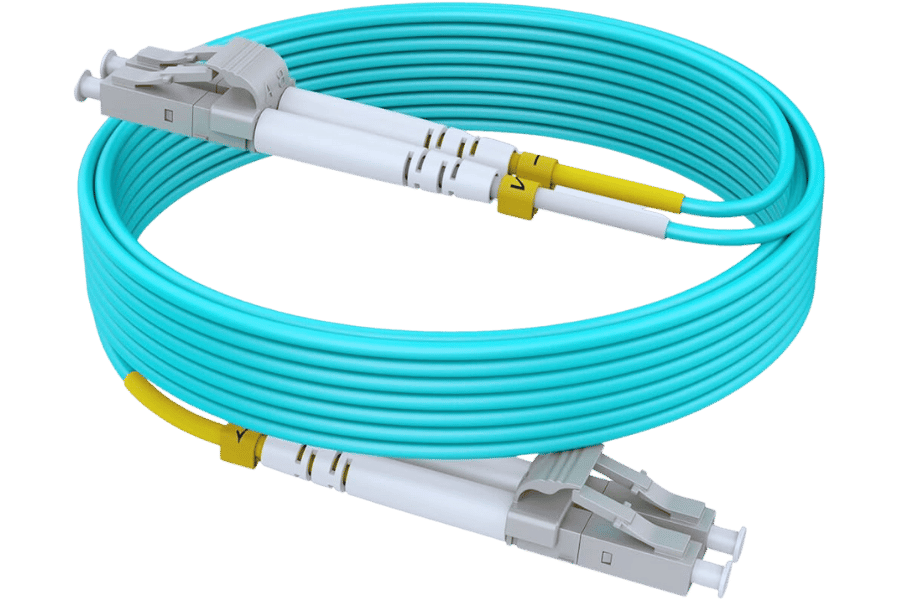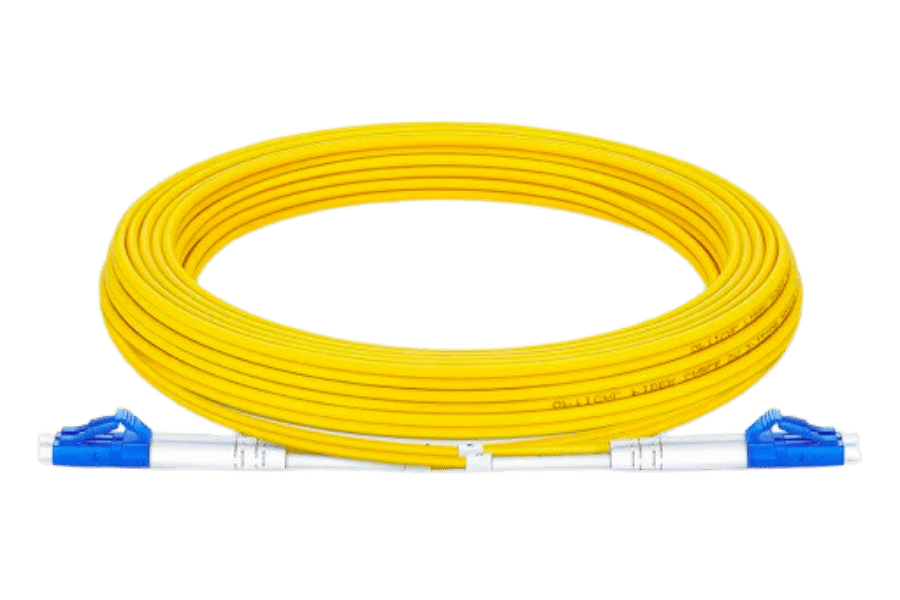In the ever-changing world of telecommunications, it is essential to know what sets single-mode and multimode fiber optic cables apart to make decisions about network infrastructure. Modern data transmission relies on fiber optic cables that ensure fast connectivity over long distances with little signal degradation. There are two types of fiber: multi-mode (MMF) and single-mode (SMF). It is necessary to choose between them when selecting the right kind for this purpose, depending on specific needs. This manual analyzes technical features, performance characteristics, and benefits of both types of fibers – single mode and multi-mode – so that professionals working in various industries can find out which suits their applications best while comparing them against each other comprehensively. Whether you plan new networks, upgrade existing ones, or just widen your horizons in this area, these insights will give you all the necessary knowledge required to deal with the complexities of optical fiber communications confidently.
Table of Contents
ToggleWhat is Multimode Fiber and How Does It Differ From Single Mode Fiber?

Multimode Fiber: Characteristics and Applications
Multimode fiber (MMF) has a larger core diameter of about 50 or 62.5 micrometers, allowing for multiple modes or light paths to be transmitted simultaneously. This feature helps the cable achieve higher bandwidth over short distances; hence, it is commonly used in local area networks (LANs) and data centers, among other applications that require short-reach connectivity. LEDs or VCSELs are commonly used as light sources in multimode fibers because they provide the necessary operational ranges at a lower cost. Nonetheless, signal quality deteriorates faster with distance due to modal dispersion in MMFs than SMFs, thus making single-mode vs multi-mode fiber optic performance quite different. For this reason, MMF works best when deployed within a range not exceeding 300-400 meters so as to balance the speed and cost efficiency of high-speed network connections.
Single Mode Fiber: Features and Uses
Typically, single-mode fiber (SMF) is defined by its small core diameter of about 8 to 10 micrometers, which permits only one light mode to propagate. This property drastically decreases modal dispersion, thereby transmitting signals over far greater distances with minimal degradation. Single-mode fibers are used in long-haul telecommunications, metropolitan area networks (MANs), and cable television (CATV) networks. Although the single mode design requires more expensive laser-based light sources than multimode fibers, it also provides higher bandwidth capacities and signal fidelities. Thus, SMFs are preferred for applications requiring ultra-fast data transfer rates across large geographical regions.
Key Differences Between Single Mode and Multimode Fiber
When it comes to single-mode fiber (SMF) and multimode fiber (MMF), there are three main differences between the two: their core diameters, how light is propagated through them, and what they are generally used for. The core of SMF is smaller, with a diameter of 8-10 micrometers, which allows only one mode of light to propagate, thus reducing modal dispersion that makes it possible for the signal to be transmitted over longer distances. It requires laser-based light sources and is mainly used in long-haul telecommunications as well as high-speed data transmission across wide areas.
On the other hand, MMF has a bigger core diameter ranging from 50-62.5 micrometers, thereby supporting multiple modes of light and causing more modal dispersion, resulting in shorter effective transmission distances. LED or VCSEL light sources are commonly used with this type of fiber, which makes it more affordable for short-reach applications such as local area networks (LANs) and data centers. In essence, SMFs are designed for use in high bandwidth connections spanning large distances, while MMs strike an equilibrium between performance and cost-effectiveness over shorter ranges.
What Are the Main Differences Between Single Mode and Multimode Fiber Optic Cables?

Core Diameter: Multimode Fiber vs Single Mode Fiber
The diameter of the core differentiates between single-mode fiber optics and multimode fiber optics. Typically, the core of multimode fibers is bigger in size; it has a diameter of about 50-62.5 micrometers, which tends to make it better for use over short distances. Due to its large core size, various modes of light can propagate at the same time through this type of fiber but with higher modal dispersion that limits its distance and bandwidth.
On the other hand, single-mode fibers have much smaller cores ranging from 8 to 10 micrometers in diameter, only allowing one mode or path for light propagation, thus reducing modal dispersion as well. Therefore, they are more suitable than any other type for long-distance communication links because they offer better signal fidelity and transmission reach capabilities at higher speeds. That’s why such fibers are mainly used within extensive telecom networks where there may be a need for fast data transfer across wide areas.
Wavelength and Light Sources: Single Mode vs Multimode
Single-mode fiber (SMF) and multimode fiber (MMF) operate using different wavelengths and light sources, distinguishing their performance and uses considerably. SMF often features laser diodes which work at either 1310 nm or 1550 nm. These wavelengths are favorable for long-distance communication because they have less attenuation and, hence, can be transmitted over longer distances without being distorted, a characteristic of single-mode cables. By using laser light sources, SMF achieves higher bandwidths, thus supporting longer-reach applications, making it ideal for telecommunication infrastructures and high-speed data networks.
On the other hand, MMF mainly uses light-emitting diodes (LEDs) or vertical-cavity surface-emitting lasers (VCSELs) that operate at 850 nm or 1300 nm, respectively. These shorter wavelengths, together with the nature of light sources employed in MMF, introduce much modal dispersion, thereby limiting its useful transmission distance and bandwidth. Nevertheless, MMFs are cheap and good enough for short-reach applications like those found within data centers, local area networks (LANs), campus networks, etc., where the distances involved are usually less than 550 meters. Therefore, MMF becomes a practical solution for such environments, given its balance between cost and performance.
Transmission Distance: Single Mode Fiber vs Multimode Fiber
Physical properties and the types of light sources used determine the transmission distance capabilities of Single Mode Fiber (SMF) and Multimode Fiber (MMF). Usually about 9 micrometers wide, SMF features a small core diameter that greatly minimizes modal dispersion, allowing signals to travel longer distances without deterioration. SMF can support more than 10 kilometers and go up to 80 km or more using specialized equipment. Therefore, this makes it ideal for use in telecommunication systems covering large areas, metropolitan networks, and massive data transfer.
On the other hand, because its core is larger (ranging from 50-62.5 micrometers), MMF exhibits higher levels of modal dispersion, resulting in increased signal attenuation with distance covered. As a result of this phenomenon, short-haul transmissions are its limitation. For instance, when operating at 10 Gbps, standard OM3 supports distances up to 300 meters, while OM4 covers up to 550 meters. Additionally, higher data rates reduce the distance even further due to more dispersion and attenuation, thus affecting the speed and range capability inherent in any fiber optic network design. Thus, MMFs find better applications within data centers where interconnection between servers is needed, but proximity among them allows for cheap installation. Such cables could not work effectively elsewhere, like campuses or enterprise networks requiring wider coverage.
How Do Single Mode and Multimode Fiber Cables Perform in Terms of Bandwidth?

Understanding Bandwidth Capabilities of Single Mode Fiber
Single Mode Fiber (SMF) has a lot of bandwidth. It can carry huge amounts of data super fast for long distances. According to TechTarget, Corning, and Cisco, the frequencies that SMF supports range from 1310nm to 1550nm. This means it can also handle very high speeds. In fact, SMFs can typically transmit at rates between 10 Gbps and 100 Gbps or more.
Its small core limits modal dispersion, which allows for high bandwidth over large areas without losing signal quality. Therefore, single-mode fiber is best suited as a backbone infrastructure connecting different parts of the world through oceans or for use in any other place where both distance and capacity need to be maximized, such as supercomputers used by NASA.
Exploring the Bandwidth Limits of Multimode Fiber
Multimode fiber (MMF) may not have the same bandwidth and distance capabilities as single-mode fiber (SMF), but it is still quite performant over short distances. Some major sources include Corning, CommScope, TechTarget, etc., which state that MMF usually supports data rates of up to 10 Gbps for 300 meters using OM3 fiber or 550 meters with OM4 fiber. With the new technology, data transmission speeds between 40 Gbps –100 Gbps are achievable over a maximum length of 150m on short wavelength division multiplexing (SWDM) capable OM5 fibers. However, its larger core size relative to single-mode fiber optic cables results in more modal dispersion, hence limiting adequate bandwidth and transmission distance compared to SMF. Thus, it can be used in LANs, data centers, and enterprise networks where high bandwidth is required over midrange distances.
Which Fiber Optic Cable is Best for Your Data Center: SMF or MMF?

Factors to Consider When Choosing Between SMF and MMF
To determine whether to use Single Mode Fiber (SMF) or Multimode Fiber (MMF) for your data center, you need to look at several key factors:
- Range: If you transmit data over long distances in your data center setup, then SMF is the right choice because it has low attenuation and minimum modal dispersion. Using advanced modulation formats such as dense wavelength division multiplexing (DWDM), SMF can maintain signal quality for more than 80 kilometers.
- Bandwidth: Single-mode fiber cables are unmatched in this area for high-performance applications that require higher bandwidths. They can support data rates of up to 100 Gbps over long distances, making them suitable for backbone infrastructures and wide-area networks. On the other hand, multimode fibers provide enough capacity for shorter links, with typical maximum lengths being around 150 meters when using OM5 fiber optic cable, where it can achieve 40Gbps speed.
- Cost: While single-mode fibers and their transceivers are more expensive than multimode ones, long-term benefits like scalability and performance may outweigh these initial expenses. In most cases, though not always, MMFs offer cheaper options, especially where buildings or campuses need connections within them only, thus striking a balance between cost-effectiveness and good performance.
- Network environment considerations should also be considered when selecting between SMFs or MMFs based on existing infrastructure and future-proofing requirements, among other things. SMFs provide excellent upgrade path potentiality but still remain advantageous under the equipment compatibility simplicity operational environment requirement.
- Ease of Installation Management: The larger core size in multimode fibers allows for easier installation and management since they have wider connector tolerances compared to single mode types, reducing the complexity associated with network installations, maintenance costs, etcetera.
These aspects will enable data center operators to make informed decisions that are aligned with their specific technical and economic goals.
Use Cases for SMF Cables in Data Centers
Because they can maintain strong signal quality over long distances, single-mode fiber (SMF) cables are useful in data centers for several important reasons. Some of the most critical uses include:
- Long-Haul Data Transmission: SMF cables are perfect for transmitting data across cities or continents because they don’t lose much signal strength.
- High-Speed Networking: SMFs are necessary for high-speed networks operating at over 100 Gbps; this allows backbone networks to work properly and ensures efficient processing and information transfer between different points within a data center.
- Future-Proofing Infrastructure: With this type of infrastructure, data centers will be able to cope with new technologies and increasing amounts of traffic transmitted through them by scaling their capabilities up accordingly. This will allow these facilities to stay competitive while keeping pace with growing needs imposed on them by changing network environments.
These scenarios show why it is so important not only to have any but also, specifically, single-mode fiber cables that can support heavy-duty operations within modern-day data centers with high-performance requirements.
Where MMF Cables Excel in Data Center Applications
Multi-mode fiber (MMF) cables are suitable for data centers because they are inexpensive and work well over limited distances. They have the following advantages.
- Cost-Efficiency: In terms of both first costs and ongoing outlays, MMF cables are generally cheaper than SMF cables. Their bigger center size makes aligning and connecting them simpler than smaller ones, thus reducing overall installation costs.
- Ease of Installation: Larger cores in multimode fiber optic cable allow more light to enter the cable. This makes it easy for technicians who may not have steady hands or good eyesight to make connections between transceivers without breaking anything, thereby simplifying and speeding up installations. This can be convenient when quick deployment or frequent changes are needed in such scenarios.
- Higher Bandwidth Over Shorter Distances: Multi-mode fibers can support high data rates, typically up to 100 Gbps, over relatively short spans like 100-150 meters using OM4 fiber. Because of this characteristic, they become an excellent choice for connecting different devices within a building or facility, such as servers with switches located in racks within the same room or adjacent rooms of data centers.
To balance performance and cost efficiency at their best in particular networking applications where distances must remain small, multimode fibers throughout the data center short-reach links are the only solution.
What are the Options for SFP Modules with single-mode and Multimode Fibers?

Differentiating Between SFP Modules for SMF and MMF
The data center network can send more information flexibly and efficiently because of the SFF modules. It is important to distinguish between single-mode fiber SFP modules and multi-mode fiber ones for compatibility reasons and the best performance. The choice between an MMF or SMF SFP module depends on which one you use.
- Wavelength and distance: 1310 nm or 1550 nm are the wavelengths at which SFP modules designed for SMF operate most optimally, this allows them cover longer distances of about 10 km or more depending on the type of module used as well as quality of fiber used. On the other hand, their counterparts designed for MMF work best at around 850nm and hence can reach only up to about 500 meters when used with OM4 fibers.
- Core size compatibility: The larger core sizes found within MMF cables, such as those with either 50 µm or 62.5 µm, are what these types of transceivers have been made to accommodate, i.e., MMF SFP modules; however, they still need much smaller cores characteristic cable like SMFs’ which are usually about nine micrometers thick if indeed light must be perfectly directed over long distances.
- Application scenarios: Long hauls and metropolitan area networks where there should be minimal loss in signal strength due to prolonged distance covered would require using an SFP module meant for single-mode fiber optic communications, thus enabling extended reach with no drop-offs in power level along the way. A short-range linkup connection can be achieved by opting for multimode optical fiber links within buildings or campuses since they have a lower cost per port than single-mode connectors, besides being easy to handle during the installation process, among other factors.
- Cost considerations: In general terms, MMFs, together with their associated cabling systems, tend to be cheaper than SMFs since they require fewer materials during the manufacturing stage. Not to mention that it also takes less time to set them up, hence reducing labor costs. In addition, they are more user-friendly, especially for people who may not have the technical skills required by other types of fibers used within specific networks.
By understanding the network’s needs and considering the attributes of both SMF SFP modules and MMFS, data centers can achieve better networking infrastructure performance at a lower cost.
Compatibility and Performance: SFP with Multimode Fiber
Multimode Fiber (MMF) SFP modules are commonly used for short-range data transmission because they work with MMF cables and are cost-effective. The following are the main benefits and considerations of using MMF SFP modules:
- Compatibility: These modules are designed to work best with multimode fiber optic cables, which usually have larger core sizes (50 µm or 62.5 µm). This enables them to effectively manage more than one light mode, thus ensuring reliable data transmission over shorter distances. For example, OM3 and OM4 fibers can support up to 100 meters and 150 meters in 10G Ethernet connections.
- Performance: MMF SFP modules mainly operate at an 850 nm wavelength, allowing fast and efficient transfer of large amounts of data within limited spaces like enterprise networks or data centers. These components also offer different rates of data transmission. 10GBASE-SR is a widely used standard due to its ability to provide high bandwidths across medium distances using multimode fiber.
- Cost Efficiency: Using MMF SFP modules helps organizations save money in several ways. Firstly, both these cables and associated transceivers tend to be cheaper compared to single-mode fiber (SMF) alternatives, making them very suitable for internal network environments where long-haul communications aren’t necessary.
By taking advantage of the compatibility and performance features inherent in MMF SFP modules, companies can establish affordable yet efficient networking systems for their short-range applications and data centers.
SFP Module Selection for Single-Mode Fiber
When it comes to choosing SFP modules for single-mode fiber (SMF), several factors need to be taken into account to ensure effective and dependable operation. In most cases, SMF SFP modules are designed for longer distances than their multi-mode counterparts, which can cover several kilometers. For this reason, SMF is best suited for long-distance communication. Below are some of the key considerations:
- Wavelength and Distance: Typically, 1310 nm, 1550 nm, or 1490 nm are the most commonly used wavelengths by SMF SFP modules depending on a specific application and required distance, making this type of fiber suitable for extensive range coverage. For instance, it can be up to 10 kilometers with 10GBASE-LR modules working at 1310 nm, while transmission may reach even 40km thanks to devices like 10GBASE-ER, which operates at 1550nm.
- Data Rates: Ensure that the SFP module supports your desired data rates. Available standard data rates for SMF SFP modules include 1Gbps, 10Gbps,40Gbps, and 100Gbps, with higher bandwidth solutions being developed as technology advances. Network performance will depend heavily upon making the right choice of an appropriate module matching the expected rate.
- Compatibility: Confirm if this particular type (model) of an SFP module will work well with existing network equipment, usually denoted by letters such as EX, GLC, etc. This means checking whether a given device is supported by the switch model series number or router brand name plus version. Vendor-specific models might bring about better results, particularly when used together with equipment produced under the same manufacturer’s name. Still, third-party ones also comply with industry standards, thereby becoming cost-effective alternatives.
- Cost: The prices charged on MMF solutions may not always reflect those associated with solutions, although in most cases, they tend to be more expensive. Considering total ownership cost (TOC), including factors such as the number of units required, installation fees, maintenance charges, and scalability options available for future use, would be helpful when comparing different types or models under consideration.
By paying attention to these key areas, businesses can confidently choose suitable SMF SFP modules for their long-range networking requirements.
Reference Sources
Frequently Asked Questions (FAQs)
Q: What is the primary difference between single-mode fiber and multimode fiber?
A: Single-mode fiber optic cables have a different core diameter than multimode fiber, and they also transmit light differently. The thinness of single-mode fibers’ cores (SMF) restricts them to transmitting light in a straight line, making them ideal for long distances. Conversely, multi-mode fibers (MMF) have thicker cores that allow light to travel through them using multiple paths simultaneously, making them better suited for short distances.
Q: Could you explain SMF vs MMF?
A: When it comes to data transmission over long distances at high speeds with minimal dispersion, single-mode fiber (SMF) is the way to go. On the other hand, multi-mode fiber (MMF) has a larger core that allows several modes of light to transmit data, thereby making it more suitable for shorter distances.
Q: What are some typical applications for single mode Fiber vs Multimode Fiber Optic Cable?
A: Single-mode fibers are used in telecommunication networks and backbone infrastructures where high data rates over long distances without much signal loss are needed, while multimode fibers are used within data centers, LANs, and premise networks where cost considerations may limit distance requirements, among other things.
Q: Why would someone choose SMF over MMF or vice versa?
A: The choice between using either Single Mode Fiber(SMF) or Multimode Fiber (MMF) depends on what is being designed. SMFs excel at high-speed transmission with low power loss per unit length but require precise alignment due to their small size, so they are best suited for longer reach. At the same time, MMs provide cheaper cabling options because they can use larger transceivers/connectors since alignment isn’t as critical as distance limitations imposed by smaller sizes would dictate.
Q: What is OM3 and How does it relate to Multimode Optical Fiber?
A: There should be an explanation of what OM3 means and its relation to multi-mode fiber (MMF) and comparisons between MMFs and Single Mode Fibers (SMFs) when selecting cables for required speeds and distances. At the same time, this classification is useful in comparing SMF versus MMF because OM3 features larger core diameters optimized for laser-based transmissions that enable them to support such high-speed data transmission like 10 Gigabit Ethernet up to 300meters when choosing between the cabling options.
Q: How does modal dispersion affect data transmission in MMF and SMF?
A: Modal dispersion occurs in a multimode fiber when different types of light travel at different speeds, causing the signal to spread over time and distance. This phenomenon restricts the ability of MMFs to send signals across long distances. On the other hand, SMF transmits light through one path only, practically eliminating modal dispersion and enabling it to support higher data rates over greater distances.
Q: What connectors are used with single-mode fiber and multimode fiber?
A: SC, LC, ST, and MTP/MPO are among the many types of connectors that can be used for optical connections into SMFs and MMs, though small core diameters may necessitate more precise installation/maintenance processes compared to larger ones typically found inside multi-mode fibers.
Q: What are some benefits of using single-mode fiber optic cable for long-distance communication?
A: Single-mode fiber optic cables offer several advantages over their counterparts when it comes to long-haul communications, such as higher bandwidth, lower losses due to attenuation, etc.; hence, they have become most widely utilized within telecommunication networks where large volumes or high-speed transmissions occur frequently over considerable distances.
Q: How does fiber core diameter affect performance in SMF vs MMF cables?
A: The performance levels achieved by any given fiber optic cable depend largely upon its core size; singlemode fibers have smaller cores that enable them to maintain signal integrity across vast geographical areas because only one mode of light passes through at a time, while multimode fibers possess larger cores which can accommodate multiple paths but suffer from modal dispersion hence perform poorly over longer spans.
Q: What role does laser source type play in choosing between SMF and MMF?
A: Choosing between SMFs and MMs requires knowing what type of laser source should be employed since this information is instrumental. Typically, narrow linewidth lasers like DFBs (Distributed Feedback) are used with single-mode fibers for long-distance or high-precision applications, while LEDs or VCSELs (Vertical-Cavity Surface-Emitting Lasers), which have larger emitting areas and are cheaper, can work well with multimode fibers for short-range data transmission.
